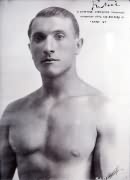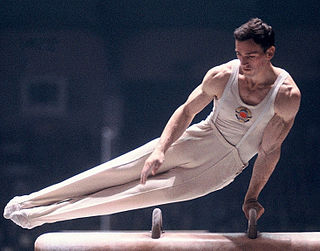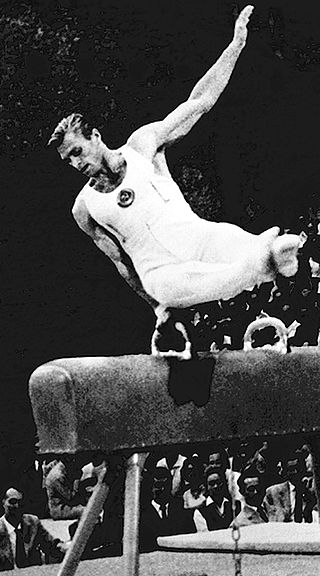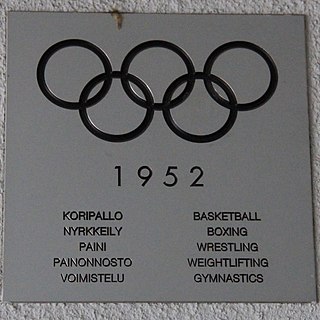
Gymnastics is a type of sport that includes physical exercises requiring balance, strength, flexibility, agility, coordination, artistry and endurance. The movements involved in gymnastics contribute to the development of the arms, legs, shoulders, back, chest, and abdominal muscle groups. Gymnastics evolved from exercises used by the ancient Greeks that included skills for mounting and dismounting a horse, and from circus performance skills.

The pommel horse is an artistic gymnastics apparatus. Traditionally, it is used by only male gymnasts. Originally made of a metal frame with a wooden body and a leather cover, the modern pommel horse has a metal body covered with foam rubber and leather, with plastic handles.

The men's pommel horse was a gymnastics event contested as part of the Gymnastics at the 1964 Summer Olympics programme at the Tokyo Metropolitan Gymnasium. The event was held on 18, 20, and 22 October. There were 128 competitors from 29 nations, with nations in the team competition having up to 6 gymnasts and other nations entering up to 3 gymnasts. The event was won by Miroslav Cerar of Yugoslavia, the nation's first medal in the pommel horse. Silver went to Shuji Tsurumi of Japan, the third man to win multiple medals in the event. Yury Tsapenko of the Soviet Union took bronze, breaking a three-Games gold medal streak for the Soviets.
This is a general glossary of the terms used in the sport of gymnastics.

The men's pommel horse event was part of the gymnastics programme at the 1932 Summer Olympics. It was contested for the fifth time after 1896, 1904, 1924, and 1928. The competition was held on Thursday, August 11, 1932. Ten gymnasts from five nations competed. Each nation was limited to three gymnasts. The event was won by István Pelle of Hungary, the nation's first medal in the pommel horse. Italy also earned its first medal in the event, with Omero Bonoli's silver. Frank Haubold took bronze, the United States' first medal in the event since 1904.

The men's artistic individual all-around event was part of the gymnastics programme at the 1932 Summer Olympics. It was the eighth appearance of the event, which was established in 1900. The competition was held from Monday, August 8, 1932, to Wednesday, August 10, 1932. Twenty-four gymnasts from five nations competed. Each nation could enter a team of 5 gymnasts; Hungary sent only 4. The event was won by Romeo Neri of Italy, the nation's first victory in the event since 1920 and fourth overall. István Pelle of Hungary took silver and Heikki Savolainen of Finland earned bronze; it was the first medal in the event for each nation.

The men's pommel horse event was part of the gymnastics programme at the 1928 Summer Olympics. It was one of seven gymnastics events for men and it was contested for the fourth time after 1896, 1904, and 1924. The competition was held on Wednesday, August 8, 1928. Eighty-eight gymnasts from eleven nations competed, with each nation having a team of 8 gymnasts. The event was won by Hermann Hänggi of Switzerland, the nation's second consecutive victory in the pommel horse. The Swiss nearly repeated their 1924 medal sweep, with 4 of the top 5, but Finland's Heikki Savolainen took bronze between silver medalist Georges Miez and fourth-place finisher Edi Steinemann. It was Finland's first medal in the event.

The men's pommel horse competition was one of eight events for male competitors in artistic gymnastics at the 1996 Summer Olympics in Atlanta. The qualification and final rounds took place on July 20, 22 and 28th at the Georgia Dome. There were 102 competitors from 31 nations, with nations in the team event having up to 7 gymnasts and other nations having up to 3 gymnasts. The event was won by Li Donghua of Switzerland, the nation's first victory in the men's pommel horse since 1928. It was the first time since 1980 that the pommel horse did not have a tie for first place. Marius Urzică earned Romania's first pommel horse medal with his silver, while Alexei Nemov earned Russia's first as a nation separate from the Soviet Union with his bronze.
The men's pommel horse competition was one of eight events for male competitors in artistic gymnastics at the 1992 Summer Olympics in Barcelona. The qualification and final rounds took place on 27 July, 29 July and 2 August at the Palau d'Esports de Barcelona. There were 93 competitors from 25 nations, with nations in the team event having 6 gymnasts while other nations could have up to 3 gymnasts. For the third consecutive Games, the pommel horse ended in a tie for the gold medal. Belarusian Vitaly Scherbo and North Korean Pae Gil-su shared the top place. It was North Korea's first medal in the event. Bronze went to Andreas Wecker of Germany.

These are the results of the men's pommel horse competition, one of eight events for male competitors in artistic gymnastics at the 1972 Summer Olympics in Munich. The qualification and final rounds took place on August 27, 29 and September 1 at the Sports Hall. There were 111 competitors from 26 nations ; nations entering the team event had 6 gymnasts while other nations could have up to 3 gymnasts. The event was won by Viktor Klimenko of the Soviet Union, the nation's fourth victory in the men's pommel horse. Sawao Kato (silver) and Eizo Kenmotsu (bronze) returned Japan to the pommel horse podium after a one-Games absence.

The men's pommel horse competition was one of eight events for male competitors in artistic gymnastics at the 1968 Summer Olympics in Mexico City. The event was held from 22 to 26 October at the Auditorio Nacional. There were 115 competitors from 27 nations, with nations in the team competition having up to 6 gymnasts and other nations entering up to 3 gymnasts. The event was won by Miroslav Cerar of Yugoslavia, the second man to successfully defend an Olympic pommel horse title. Olli Laiho of Finland took silver, while Mikhail Voronin of the Soviet Union finished with bronze. Japan's three-Games podium streak in the event ended, while the Soviet streak stretched to five Games.

The men's pommel horse competition was one of eight events for male competitors in artistic gymnastics at the 1960 Summer Olympics in Rome. It was held on 5, 7, and 10 September at the Baths of Caracalla. There were 128 competitors from 28 nations, with nations in the team competition having up to 6 gymnasts and other nations entering up to 2 gymnasts. There was a tie for first place in the pommel horse. Boris Shakhlin of the Soviet Union and Eugen Ekman of Finland each received a gold medal. It was the third consecutive Games with a gold medal for the Soviets, as Shakhlin became the first man to successfully repeat as Olympic champion in the event. Ekman's medal was the only medal in men's artistic gymnastics in 1960 that did not go to the Soviet Union or Japan. Third place and the bronze medal went to Japan's Shuji Tsurumi.

The men's pommel horse competition was one of eight events for male competitors in artistic gymnastics at the 1956 Summer Olympics in Melbourne. It was held from 3 to 7 December at the Melbourne Festival Hall. There were 63 competitors from 18 nations, with nations in the team competition having up to 6 gymnasts and other nations entering up to 3 gymnasts. The event was won by Boris Shakhlin of the Soviet Union, the nation's second consecutive victory in the pommel horse. Takashi Ono earned Japan's first medal in the event with his silver. Soviet Viktor Chukarin became the first man to win multiple medals in the pommel horse, adding a bronze to his 1952 gold.

The men's vault event was part of the gymnastics programme at the 1928 Summer Olympics held in Amsterdam. It was one of seven gymnastics events for men and it was contested for the fourth time after 1896, 1904, and 1924. Scores from the vault event were added to the results from other individual apparatus events to give aggregate scores for the individual and team all-around events. There were 85 competitors from 11 nations. Each nation had a team of 8 gymnasts; three of the 88 men did not start. The event was won by Eugen Mack of Switzerland, the nation's first victory in the event and first medal since 1896. Emanuel Löffler gave Czechoslovakia its second consecutive silver medal. Stane Derganc's bronze was Yugoslavia's first medal in the event.

The men's vault competition at the 1936 Summer Olympics was held at the Waldbühne on 10 August. It was the sixth appearance of the event. There were 110 competitors from 14 nations, with each nation sending a team of up to 8 men. The event was won by Alfred Schwarzmann of Germany, the nation's first victory in the event since 1896 and second overall. Eugen Mack of Switzerland earned silver, the first man to win multiple medals in the event. Another member of the host German team, Matthias Volz, took bronze.

The men's rings competition at the 1936 Summer Olympics was held at the Waldbühne on 10 and 11 August. It was the sixth appearance of the event. There were 111 competitors from 14 nations, with each nation sending a team of up to 8 men. The event was won by Alois Hudec of Czechoslovakia, the nation's first victory after winning two silver medals and two bronze medals in 1924 and 1928. Leon Štukelj was the silver medalist in Berlin, the second man to earn two medals in the rings after his 1928 gold. Host Germany took a bronze medal, its first in the rings since 1896, as Matthias Volz finished third.

The men's parallel bars competition at the 1936 Summer Olympics was held at the Waldbühne on 10 and 11 August. It was the sixth appearance of the event. There were 110 competitors from 14 nations, with each nation sending a team of up to 8 men. The event was won by Konrad Frey of Germany, the nation's first victory in the event since 1896. Germany also took the bronze, as Alfred Schwarzmann finished third. Second place and the silver medal went to Michael Reusch of Switzerland. Germany was the first nation to have two gymnasts win the parallel bars.

The men's horizontal bar competition at the 1936 Summer Olympics was held at the Waldbühne on 10 and 11 August. It was the sixth appearance of the event. There were 110 competitors from 14 nations, with each nation sending a team of up to 8 men. The event was won by Aleksanteri Saarvala of Finland, the nation's first victory in the event. Germany took silver and bronze, as Konrad Frey finished second and Alfred Schwarzmann finished third.

The men's pommel horse competition at the 1948 Summer Olympics was held at Earls Court Exhibition Centre on 12 and 13 August. It was the seventh appearance of the event. There were 121 competitors from 16 nations, with each nation sending a team of up to 8 gymnasts. The event ended in a three-way tie for the gold medal, with all three winners from Finland: Paavo Aaltonen, Veikko Huhtanen, and Heikki Savolainen. It was the third time the medals had been swept in the event. Another three-way tie would occur in 1988. It was Finland's first victory in the event, and first medal since 1928.

The men's pommel horse competition at the 1952 Summer Olympics was held at Töölö Sports Hall, Exhibition Hall I from 19 to 21 July. It was the eighth appearance of the event. There were 185 competitors from 29 nations, with each nation sending up to 8 gymnasts. The event was won by Viktor Chukarin as the Soviet Union swept the medals in its debut. It was the fourth medal sweep in the event, and last before apparatus finals with a two-gymnast-per-nation limit made further sweeps impossible. Yevgeny Korolkov and Hrant Shahinyan tied for silver.















